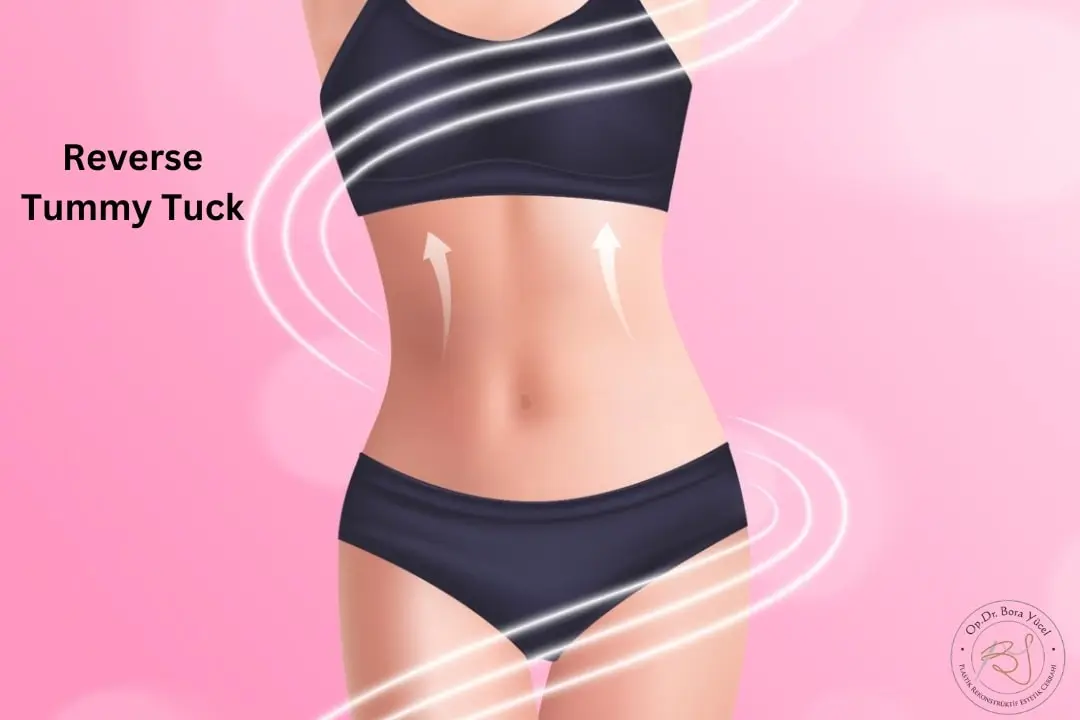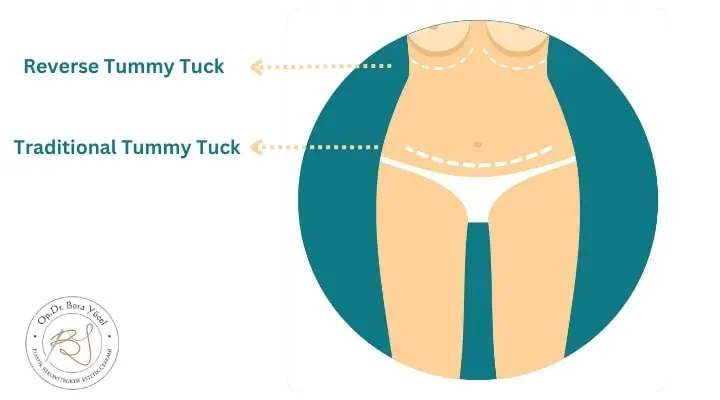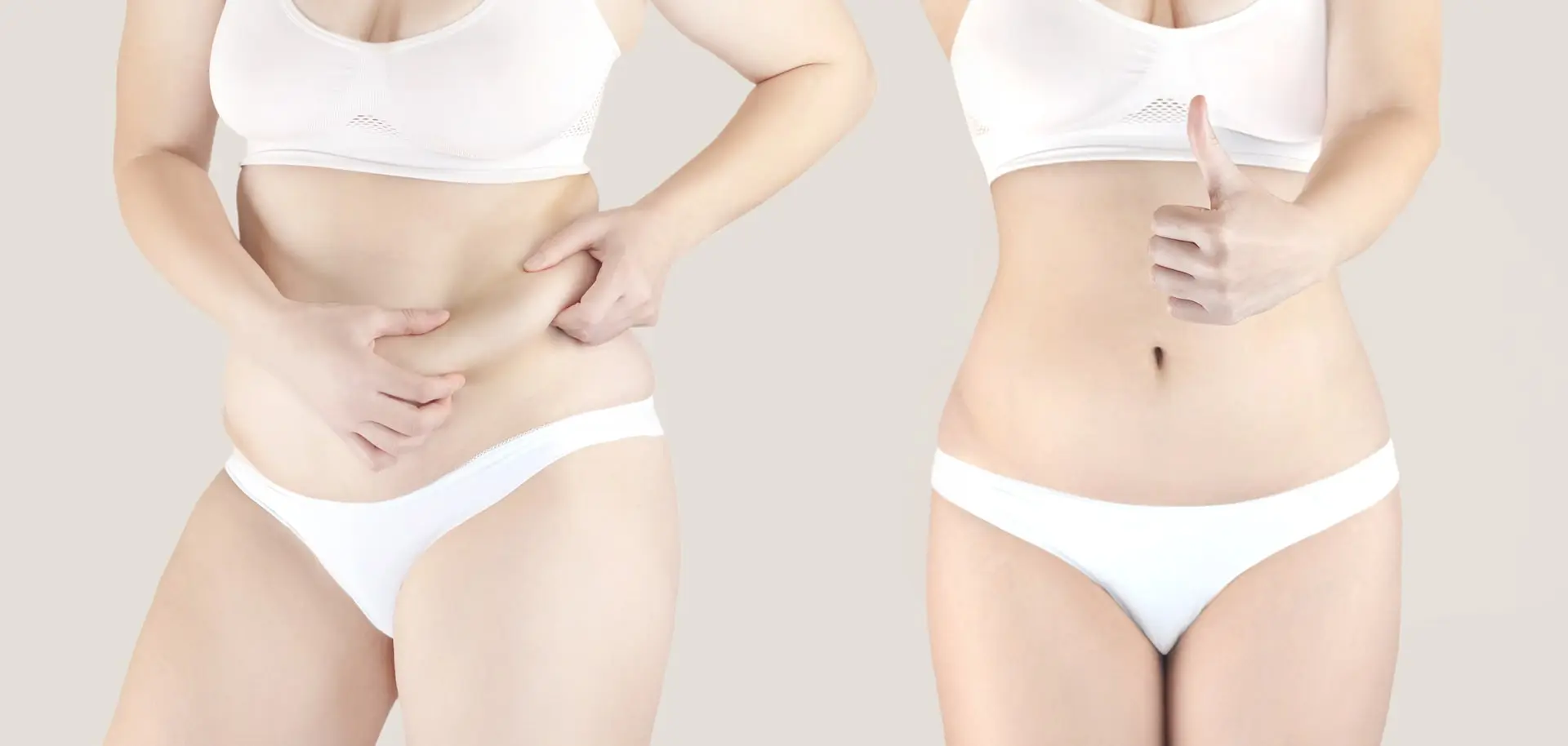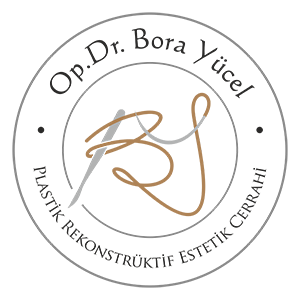
What is a reverse tummy tuck (abdominoplasty)?
A reverse tummy tuck is a surgical procedure performed to lift and tighten loose, excess skin in the upper abdomen. This procedure is sometimes called a reverse abdominoplasty. This technique is an ideal treatment for people who are happy with the appearance of their lower abdomen but have excess fat and sagging skin in the upper abdominal area.
Who needs a reverse tummy tuck?
Before considering a reverse tummy tuck, a comprehensive evaluation with an experienced plastic surgeon is required. During the consultation, your medical history and aesthetic goals will be examined in detail. This will help you decide if you are a suitable candidate for the procedure.
- This procedure is ideal for people with excess skin and fat in the upper abdomen.
- Candidates should not have muscle weakness in the lower abdomen.
- It is a good option for men who experience sagging skin due to excessive weight loss, or for women who experience sagging skin on their bodies after pregnancy.
- Smoking should be stopped before and after surgery to ensure healing and accelerate the healing process.
- It is recommended to be at your ideal weight to get the best results.
- In order to have a comfortable surgical process and recover faster, your general health condition should be good.
- You should follow your surgeon's care instructions for optimal results and a successful recovery.
Benefits of reverse tummy tuck surgery
Reverse tummy tuck generally targets a smoother upper abdomen by addressing excess skin and fat tissue in your upper abdomen. Reverse tummy tuck surgery generally has the following benefits;
Tightens your skin
Addresses skin laxity problems that cannot be addressed by age, exercise and diet.
Improves the upper abdomen
Reverse tummy tuck helps to tighten and smooth this abdominal area by targeting excess and sagging skin, especially in the upper abdomen.
Minimal scarring
In contrast to the traditional tummy tuck procedure, scars are less visible in a reverse tummy tuck, because the incisions are fixed with sutures just below the breasts. The incision scars are thus well hidden in the breast folds.
Faster recovery time
It has a faster healing process than traditional tummy tuck. Therefore, you can return to normal life in a shorter time.
Improves general body contours
Removing excess skin and fat tissues in the upper abdomen with a reverse tummy tuck makes your body look younger and makes you feel more confident and comfortable. It also addresses stubborn sagging skin, especially in pregnant women after childbirth.
Can be combined with other aesthetic procedures
Reverse abdominoplasty can be combined with liposuction, breast augmentation or maternity aesthetic procedures if a more comprehensive result is desired.
Clothes fit better
With a reverse tummy tuck, clothes will look more pleasing on a smoother and flatter abdominal structure.
How is a reverse abdominoplasty performed?
In reverse abdominoplasty, the procedure begins with general and local anaesthesia. The incisions are made below the inframammary fold, the so-called inframammary incision, and continue under the other breast.
In the next stage, the upper abdominal skin is meticulously separated from the rib cage and repositioned in a higher position, excess skin is removed. The remaining skin is then tightened and secured with sutures just below the breasts. The scars are thus well hidden within the breast folds.
Depending on the situation and need, your plastic surgeon can also repair and tighten your upper abdominal muscles. Thus, the upper abdominal area gains a tighter, smoother and younger appearance.
Which aesthetic treatments can be performed with a reverse tummy tuck?
For those who want a more comprehensive transformation, a reverse tummy tuck can be combined with other aesthetic treatments such a mommy makeover. In such cases, surgeons can also perform a breast augmentation and breast lift operation at the same time by using excess skin and tissues according to the patient's request. With the liposcution method, excess fat tissues of the body can be removed for sufficient filling material for these breasts. The average time to complete a reverse abdominoplasty surgery is 2-3 hours.
What can be expected during the recovery process after reverse tummy tuck surgery?
The recovery process from reverse tummy tuck surgery may vary from person to person.
In the first recovery phase, a compression garment is worn after surgery. The compression garment supports healing and reduces existing pain. Surgical sutures are removed after 10 days. Swelling and bruising can be expected in the treated area for about 1-2 weeks. However, this is temporary and will disappear over time with the healing process. Eventually, the initial healing phase may take 10-15 days.
Most patients can return to work 2 weeks after surgery and can take light walks and exercise. Strenuous activities and heavy work should be avoided for 4-6 weeks. The side effects of the surgery usually disappear within a few months. Since it takes time for the swelling to decrease due to healing and the body to fit properly, it may take up to 6-12 months for the final results to be evident.
In order to maintain the long-term results of reverse tummy tuck surgery, it is necessary to do regular sports and eat a balanced diet.
Are there any scars after a reverse tummy tuck?
In contrast to the traditional tummy tuck procedure, scars are less visible in a reverse tummy tuck, because the incisions are fixed with sutures just below the breasts. The incision scars are thus well hidden within the breast folds.
After the operation, the scars are still reddish and raised with a rough texture, but over time, during the healing process, they begin to turn pink and become smooth. Finally, they eventually turn into a colour close to your own skin colour.
How long will the results from a reverse tummy tuck last?
It is desirable that the results of the reverse tummy tuck are long-lasting, even if they are not permanent for life. Some factors such as pregnancy, excessive weight gain or hormonal disorders can affect the results of a reverse tummy tuck.
If you want the results of the reverse abdominoplasty to be at the desired level and long-lasting;
- A balanced diet and regular exercise should be done,
- Regular follow-up examinations should not be interrupted,
- Smoking and tobacco products should be avoided, alcohol consumption should be limited and a healthy life should be led.
How much is a reverse tummy tuck in Turkey?
Turkey is an affordable country compared to other countries in reverse tummy tuck prices. Generally, operation costs may vary depending on the location of the clinic, the surgeon's experience level and the variety of the procedure performed.
The average cost of reverse tummy tuck in Turkey is between 3,000 and 6,000 euros. In the UK, this cost ranges from approximately 6,000 to 10,000 euros, and in Europe as a whole from 4,000 to 11,000 euros.
How is a reverse tummy tuck different than a traditional tummy tuck?
A reverse tummy tuck and a traditional tummy tuck (abdominoplasty) are both cosmetic procedures designed to improve the appearance of the abdominal area, but they focus on different areas and use different techniques.

| Types of facelift | Traditional Tummy Tuck | Reverse Tummy Tuck |
| Targeted area | Excess skin and fat in the lower abdomen are removed, and the abdominal muscles are tightened. | Excess skin in the upper abdomen is removed, but the muscles are usually not tightened. |
| Incision location & technique | A horizontal incision is made in the groin area, along the bikini line. | Incisions are made in the natural crease under the breast (inframammary fold). |
| Incision size | The incision is usually longer and can extend from hip to hip. | The incision is made along the inframammary line and is usually more limited. |
| Procedure time | About 2-4 hours. | Shorter, usually completed in 2-3 hours. |
| Recovery time | Full recovery takes 4-6 weeks. Movement restriction is required for the first 6 weeks, and wearing a corset is recommended. | Heals faster, with recovery usually within 2-4 weeks. |
| Muscle repair | If the abdominal muscles are separated (diastasis recti), they are repaired. | Only excess skin is removed, and muscle intervention is done only if necessary. |
| Price | More expensive due to being a longer and more complex procedure. | More affordable, but costs can increase with combined procedures. |
| Who is it suitable for? | People with excess skin and fat in the lower abdomen after pregnancy or significant weight loss. | People with excess skin in the upper abdomen but no significant lower abdominal issues. |
Reverse tummy tuck before after
The reverse tummy tuck treatment before and after photos in Turkey provide real examples of the comprehensive changes that the reverse tummy tuck procedure can bring to a person's upper abdominal appearance. Patients can see tangible improvements by examining these photos and gain confidence in the treatment. Comparing the before and after images helps individuals set realistic expectations and develop trust and understanding between patients and clinics.

Reverse abdominoplasty reviews
Reviews from patients who have undergone reverse tummy tuck surgery provide valuable information about the advantages and disadvantages of the procedure. These reviews provide insight into the support provided by the clinic during the procedure and recovery process and whether the reverse tummy tuck results are satisfactory. Reviewing patient experiences to learn more about reverse tummy tuck will help you understand whether the procedure will meet your expectations.

